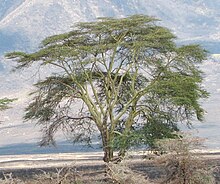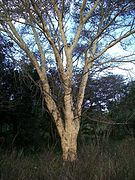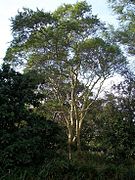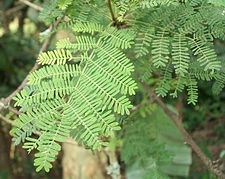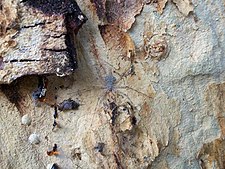Description
The trees grow to a height of 15–25 m (49–82 ft). The characteristic bark is smooth, powdery and greenish yellow, although new twigs are purple, flaking later to reveal the characteristic yellow. [4] It is one of the few trees where photosynthesis takes place in the bark. Straight, white spines grow from the branch nodes in pairs. The leaves are twice compound, with small leaflets (8 mm × 2 mm or 0.3 in × 0.1 in). The flowers are produced in scented pale cream spherical inflorescences, clustered at the nodes and towards the ends of the branches. The pale brown pods contain 5–10 elliptical, flattened green seeds and are 5–19 cm (2.0–7.5 in) long, straight, flat and rather papery, the segments are mostly longer than they are wide, often breaking up to form small clusters of segments each containing an individual seed. As the pods mature they change colour from green to pale greyish brown. [4]
Fever trees are fast growing and short lived. They have a tendency to occur as single-aged stands, and are subject to stand-level diebacks that have been variously attributed to elephants, water tables, and synchronous senescence. [5] [6] [7] [8]

Acacia s.l., known commonly as mimosa, acacia, thorntree or wattle, is a polyphyletic genus of shrubs and trees belonging to the subfamily Mimosoideae of the family Fabaceae. It was described by the Swedish botanist Carl Linnaeus in 1773 based on the African species Acacia nilotica. Many non-Australian species tend to be thorny, whereas the majority of Australian acacias are not. All species are pod-bearing, with sap and leaves often bearing large amounts of tannins and condensed tannins that historically found use as pharmaceuticals and preservatives.

Vachellia farnesiana, also known as Acacia farnesiana, and previously Mimosa farnesiana, commonly known as sweet acacia, huisache, or needle bush, is a species of shrub or small tree in the legume family, Fabaceae. Its flowers are used in the perfume industry.

Acacia, commonly known as wattles or acacias, is a genus of about 1,084 species of shrubs and trees in the subfamily Mimosoideae of the pea family Fabaceae. Initially, it comprised a group of plant species native to Africa, South America and Australasia, but is now reserved for species mainly from Australia, with others from New Guinea, Southeast Asia and the Indian Ocean. The genus name is Neo-Latin, borrowed from the Greek ἀκακία, a term used in antiquity to describe a preparation extracted from Vachellia nilotica, the original type species.

Vachellia cornigera, commonly known as bullhorn acacia, is a swollen-thorn tree and Myrmecophyte native to Mexico and Central America. The common name of "bullhorn" refers to the enlarged, hollowed-out, swollen thorns that occur in pairs at the base of leaves, and resemble the horns of a steer. In Yucatán it is called "subín", in Panamá the locals call them "cachito". The trees are commonly found in wet lowlands

Vachellia collinsii, previously Acacia collinsii, is a species of flowering plant native to Central America and parts of Africa.

Vachellia tortilis, widely known as Acacia tortilis but now attributed to the genus Vachellia, is the umbrella thorn acacia, also known as umbrella thorn and Israeli babool, a medium to large canopied tree native to most of Africa, primarily to the savanna and Sahel of Africa, but also occurring in the Middle East.
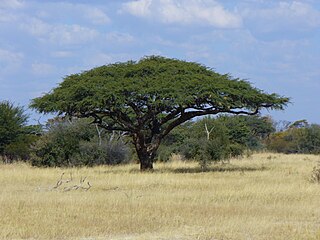
Vachellia erioloba, the camel thorn, also known as the giraffe thorn, mokala tree, or Kameeldoring in Afrikaans, still more commonly known as Acacia erioloba, is a tree of southern Africa in the family Fabaceae. Its preferred habitat is the deep dry sandy soils in parts of South Africa, Botswana, the western areas of Zimbabwe and Namibia. It is also native to Angola, south-west Mozambique, Zambia and Eswatini. The tree was first described by Ernst Heinrich Friedrich Meyer and Johann Franz Drège in 1836. The camel thorn is a protected tree in South Africa.

Acacia mearnsii, commonly known as black wattle, late black wattle or green wattle, is a species of flowering plant in the family Fabaceae and is endemic to south-eastern Australia. It is usually an erect tree with smooth bark, bipinnate leaves and spherical heads of fragrant pale yellow or cream-coloured flowers followed by black to reddish brown pods. In some other parts of the world, it is regarded as an invasive species.

Vachellia nilotica, more commonly known as Acacia nilotica, and by the vernacular names of gum arabic tree, babul, thorn mimosa, Egyptian acacia or thorny acacia, is a flowering tree in the family Fabaceae. It is native to Africa, the Middle East and the Indian subcontinent. It is also considered a 'weed of national significance' and an invasive species of concern in Australia, as well as a noxious weed by the federal government of the United States.

Vachellia karroo, commonly known as the sweet thorn, common acacia, Karoo thorn, Cape gum or cockspur thorn, is a species of Vachellia, in the Mimosa sub-family (Mimosoideae) of the Fabaceae or pea family, which is native to southern Africa from southern Angola east to Mozambique, and south to South Africa.

Senegalia laeta, the gay acacia or daga, is a legume found in the family Fabaceae. It was formerly included in the genus Acacia.
Vachellia nubica is a species of plant in the family Fabaceae.

Vachellia seyal, the red acacia, known also as the shittah tree, is a thorny, 6– to 10-m-high tree with a pale greenish or reddish bark. At the base of the 3–10 cm (1.2–3.9 in) feathery leaves, two straight, light grey thorns grow to 7–20 cm (2.8–7.9 in) long. The blossoms are displayed in round, bright yellow clusters about 1.5 cm (0.59 in) diameter.

Vachellia sieberiana, until recently known as Acacia sieberiana and commonly known as the paperbark thorn or paperbark acacia, is a tree native to southern Africa and introduced into Pakistan. It is used in many areas for various purposes. The tree varies from 3 to 25 m in height, with a trunk diameter of 0.6 to 1.8 m. It is not listed as being a threatened species.

The black-tailed tree rat, also called black-tailed acacia rat or black-tailed thallomys,, is a species of rodent in the family Muridae. It is found in Angola, Botswana, Namibia and South Africa, where its natural habitat is subtropical or tropical dry shrubland. It is both nocturnal and arboreal and makes bulky nests in the trees, often acacias, where it feeds on leaves and buds.
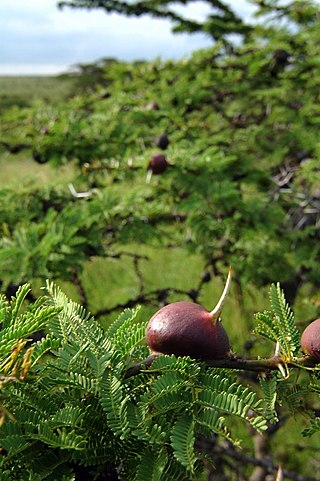
Vachellia drepanolobium, more commonly known as Acacia drepanolobium or whistling thorn, is a swollen-thorn acacia native to East Africa. The whistling thorn grows up to 6 meters tall. It produces a pair of straight spines at each node, some of which have large bulbous bases. These swollen spines are naturally hollow and occupied by any one of several symbiotic ant species. The common name of the plant is derived from the observation that when wind blows over bulbous spines in which ants have made entry and exit holes, they produce a whistling noise.

Vachellia is a genus of flowering plants in the legume family, Fabaceae, commonly known as thorn trees or acacias. It belongs to the subfamily Mimosoideae. Its species were considered members of genus Acacia until 2009. Vachellia can be distinguished from other acacias by its capitate inflorescences and spinescent stipules. Before discovery of the New World, Europeans in the Mediterranean region were familiar with several species of Vachellia, which they knew as sources of medicine, and had names for them that they inherited from the Greeks and Romans.

Vachellia reficiens, commonly known as red-bark acacia, red thorn, false umbrella tree, or false umbrella thorn, is a deciduous tree or shrub of the pea family (Fabaceae) native to southern Africa, often growing in an upside-down cone shape and with a relatively flat crown.

Vachellia flava, synonym Acacia ehrenbergiana, is a species of drought-resistant bush or small tree, commonly known as salam in Arabic. It is found in the Sahara, the northern Sahel, parts of East Africa, the Arabian Peninsula and Iran.

Vachellia abyssinica, the flat top acacia, is a tree up to 16 m tall.
